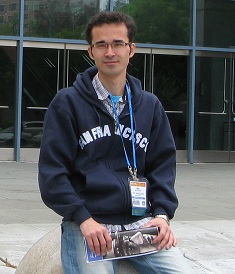
Lately, we have been hearing a lot about the extraterrestrial experiences of Iranians, both actual and desired. Iranian-American NASA engineer (and heart throb) Bobak Ferdowsi, who gained fame for his distinctive hairdo as well as his skill in guiding the Mars Rover landing, was the First Lady’s guest at President Obama’s State of the Union address, thanks to his efforts to inspire kids to pursue their education in the STEM fields.
Meanwhile, Iran successfully sent a monkey into space and back, prompting president Mahmoud Ahmadinejad to declare that he would like to become the nation’s very first astronaut. While the prospect of Iran’s controversial president being launched into orbit in a space ship intrigued many both inside Iran and out, Iran’s ability to advance the frontiers of science is being undermined by its government’s practice of putting some of its brightest scientists in prison.
Iranians take justifiable pride in their space program and other scientific endeavors and Iran has invested significant resources into the development of a large number of distinguished scientists. At the same time, Iranian authorities maintain that when these scientists go abroad to hold fellowships at foreign universities or attend scientific conferences, they are recruited by the CIA, the Israeli Mossad and other enemies to betray their country by joining a pervasive plot to undermine the Islamic Republic. This shady plot is known as the Enghelab-e Makhmali, or the “velvet revolution.”
Just as the country desperately needs its highly trained scientists to benefit society, Iran’s security apparatus seems to desperately need to perpetuate the notion of this ongoing insidious conspiracy in order to justify their existence and their grip on the reins of power. In order to accomplish this purpose, the authorities seem willing to sacrifice many of Iran’s most distinguished citizens, whether they be scientists, film makers, scholars or artists. Many have been imprisoned while others join the growing brain drain of Iranians seeking relief through self-exile.
One example of Iran’s persecution of its best and brightest is that of Omid Kokabee, a young physicist specializing in optics and photonics. He had been pursuing doctoral studies at the University of Texas, Austin when he went to Iran to visit his family. He was arrested in February 2011 and in May 2012, after an unfair trial in a Revolutionary Court at which reportedly no evidence was presented against him, he was sentenced to ten years in prison for allegedly conspiring with enemies of Iran and receiving “illegitimate funds.”
While in detention he was held in solitary confinement, subjected to prolonged interrogations, and pressured to make a confession. His interrogators reportedly threatened that he would be tortured and that professors at Iranian universities with whom he had worked would be arrested. During questioning, he was reportedly made to write down details of individuals he had seen in embassies or at conferences, and was told by those questioning him that some of the people he had met were CIA operatives.
The presiding judge at his trial, Abolghasem Salavati, is notorious for the harsh sentences he imposes on those charged with dubious crimes against “national security.” Amnesty International has repeatedly condemned proceedings held in Iran’s Revolutionary Courts as inherently unfair, where defendants are not allowed to review any evidence against them, much less contest the charges, and where confessions obtained under torture or other forms of duress are admitted as evidence.
Omid Kokabee’s friends and colleagues at the University of Texas created a video in which they testify to their admiration for his character and his dedication to science, and plead for his release. A petition on his behalf has been created and organizations ranging from the Committee of Concerned Scientists, American Physical Society, Scholars at Risk, and the American Association for the Advancement of Science, have called for his release.
Iran cannot afford to lose its scientists for the sake of promoting this giant conspiracy theory. As it is, several of its scientists have been assassinated in mysterious attacks. The Iranian government maintains that the same dark forces who lure their scientists to conspire against the government also recruit Iranian traitors to murder scientists; one Iranian has been executed and several others face death sentences after “confessing” on Iranian TV to participation in these assassination plots.
Iran hopes to achieve international recognition for its scientific advances. An essential means of furthering this goal would be to institute fundamental reforms to its legal system to ensure fair and impartial trials including the implementation of strict rules of admissible evidence, rejection of the use of coerced confessions, and the elimination of all the vaguely worded and nebulous national security related offenses. This way Iran’s scientists will acquire the confidence they need so that they do not have to fear being subjected to capricious charges when they engage in crucial exchange of ideas with international colleagues, and so they will not have to choose between risking prison if they remain in Iran or leaving their homeland. Then Iran’s talented and dedicated scientists will be able to concentrate on the goal of advancing science for the benefit of their country and its people, and if that happens, the stars won’t even be the limit!
